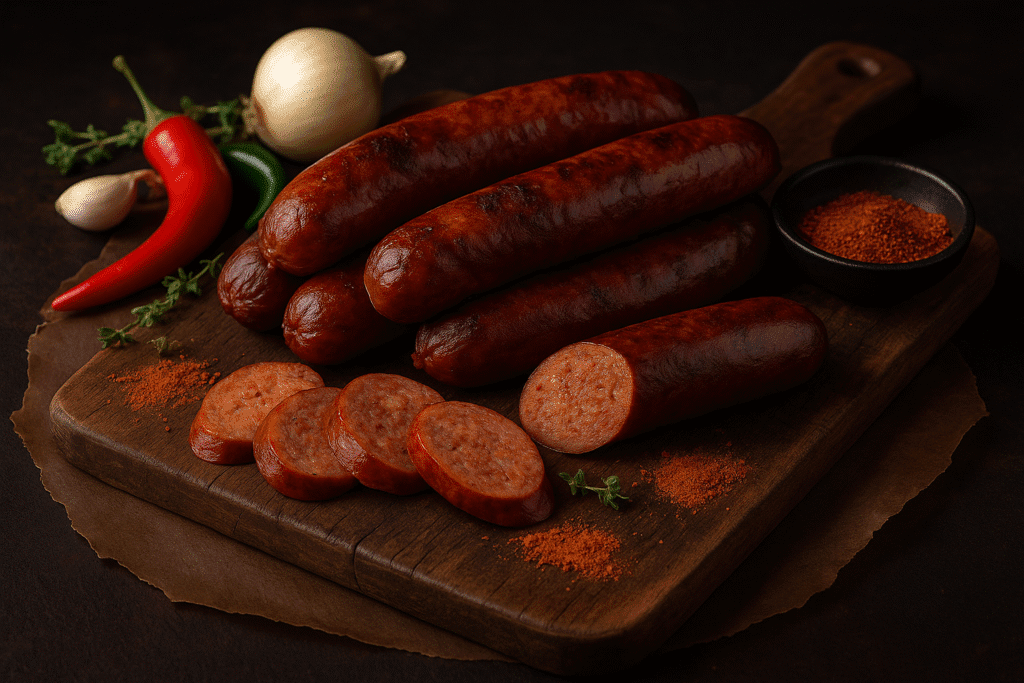Picture this: the rich aroma of smoky spices filling your kitchen, a sizzling skillet on the stove, and the promise of a meal that feels like a warm hug. That’s the magic of crafting your own homemade creations dishes that transform ordinary dinners into unforgettable experiences.

Table of Contents
Chicken andouille sausage
What makes this recipe special? It starts with juicy chicken thighs, which deliver the perfect balance of flavor and moisture. Unlike leaner cuts, thighs ensure every bite stays tender while absorbing bold seasonings like paprika, garlic, and thyme. The result? A robust, smoky profile that store-bought versions just can’t match.
Whether you’re simmering a hearty gumbo or grilling links for a backyard feast, these ideas adapt to your cravings. You’ll learn how to grind, season, and smoke meat with care—testing flavors as you go—so every batch reflects your personal touch.
Ready to elevate your cooking? This guide walks you through each step, from selecting quality ingredients to pairing your masterpiece with sides that shine. Say goodbye to bland meals and hello to restaurant-worthy dishes made right at home.
Explore Versatile chicken andouille sausage Recipes
Imagine transforming your meals with a single ingredient that bridges Southern tradition and modern creativity. This protein shines in everything from slow-simmered stews to quick skillet meals, adapting to your culinary vision while delivering bold, smoky notes.
A proper dark roux forms the soul of authentic gumbo. Combine equal parts flour and oil in a heavy pot, stirring constantly over medium heat. The mixture transforms from pale blond to rich mahogany in 25-30 minutes—patience prevents burning while unlocking nutty depth. This base pairs perfectly with sliced links, creating layers of flavor.
Tradition Meets Innovation
Classic jambalaya gains new life when balanced with fresh poblano peppers or roasted tomatoes. For charcuterie boards, pan-sear slices until crispy and serve with tangy pickles. Adjust pepper levels to control spice intensity, or swap thyme for smoked paprika in modern twists.
Key tips: Maintain medium low heat when building your roux, and taste as you season. Let gumbo simmer 45 minutes to meld flavors. Whether honoring heritage or experimenting, time and technique turn simple ingredients into extraordinary meals.
Essential Technique and Preparation Tips
Precision separates good dishes from unforgettable ones. Every step—from measuring spices to monitoring heat—shapes the final result. Master these foundational practices to ensure your meals deliver bold, balanced flavors consistently.
Prepping Ingredients for Optimal Flavor
Start by seasoning meat thoroughly with salt and spices. Mixing by hand ensures even distribution before grinding. Always test a small patty in your skillet—adjusting seasoning early prevents bland results.
Quality stock acts as a flavor amplifier. Use homemade or low-sodium versions to control salt levels. For roux, measure oil and flour precisely (1:1 ratio works best). A heavy pot prevents scorching during long simmering.
Cooking Methods: Smoking, Grinding, and More
Grind meat chilled to maintain texture. Keep equipment cold for clean cuts. When smoking, maintain 225°F—low heat preserves moisture while infusing smoky depth.
For stews, add stock gradually. Stirring every 10 minutes develops richness without burning. Taste as you go; flavors intensify over time. A Dutch oven’s even heat makes it ideal for braising or simmering.
Remember: 1 cup of liquid reduces by half in 30 minutes. Adjust quantities early to avoid overly thick results. Consistent technique turns simple ingredients into culinary triumphs.
Building a Flavor Foundation: Essential Ingredients

Flavor foundation ingredients
Key Components: Chicken Stock, Spices, and Vegetables
Fat acts as the glue that binds flavors. Rendered chicken fat or butter adds richness, while caramelized onions and peppers release natural sweetness. These aromatics form the holy trinity—a Cajun staple that builds complexity.
Quality stock amplifies savory notes. Use homemade versions to control salt levels. Freshly ground spices like paprika or thyme ensure vibrant taste. A pinch more or less can shift a dish from flat to boldly seasoned.
The Art of the Roux and Its Impact on Flavor
A dark roux starts with equal parts fat and flour. Cooked slowly, it develops nutty undertones that define gumbo and étouffée. Stir constantly over medium heat—patience prevents bitterness.
Butter enhances creaminess, while oil withstands higher temps. Adjust cooking time for lighter or deeper hues. Paired with smoked andouille, this technique bridges tradition and modern flair. Master it, and your dishes will rise to the top.
Elevating Your Meal with Creative Serving Ideas
Transform your plate into a canvas where bold flavors meet eye-catching design. Thoughtful presentation amplifies the dining experience, turning familiar dishes into conversation starters. Let’s explore how to balance taste and aesthetics effortlessly.

Creative serving ideas
Pairing with Sides: Rice, French Bread, and More
Start with a base of fluffy rice to soak up rich gravies or sauces. Its neutral profile lets smoky spices shine while adding comforting texture. For crunch, serve toasted French bread on the side—its golden crust contrasts beautifully with tender proteins.
Incorporate diced bell peppers into your plating for vibrant color. Their bright red or yellow hues create visual pop against earthy tones. Garnish with fresh herbs like parsley or chives to highlight key seasoning notes without overwhelming the palate.
| Side Dish | Pairing Tip | Visual Impact |
| Jasmine Rice | Shape into molds for height | Contrasts with dark sauces |
| Grilled Vegetables | Arrange in rainbow order | Adds natural brightness |
| Crusty Bread | Slice diagonally for texture | Golden-brown accents |
Troubleshooting and Perfecting Your Recipe
Even seasoned cooks face challenges when balancing bold flavors and precise techniques. Identifying common missteps early ensures your dish stays on track, transforming potential disasters into learning opportunities.
Common Pitfalls and How to Avoid Them
Overheating your roux is a frequent issue. Maintain lower heat to prevent burning—aim for medium-low. Stir constantly for 25-30 mins until it reaches a deep amber hue. If it smells bitter, start over.
Timing matters with delicate proteins. Add shrimp in the last 5 mins of cooking. This prevents rubbery textures. Similarly, filé powder should be stirred in off the heat to avoid gumminess.
Adjusting Seasonings and Cooking Time for Best Results
If flavors fall flat, add black pepper or thyme in small increments. Taste after each adjustment. Too spicy? Balance with a splash of broth or dash of sugar.
For stews, simmer uncovered if too thin. Extend cooking time by 10-15 mins to thicken. Stir every 5 mins to prevent sticking. Always use a timer for consistency.
| Issue | Quick Fix | Prevention Tip |
| Bland Seasoning | Add ¼ tsp thyme + pinch black pepper | Test spice mix before cooking |
| Overcooked Proteins | Remove shrimp immediately; chill | Set timer for last 5 mins |
| Burnt Roux | Discard; restart with lower heat | Use heavy-bottomed pot |
Track changes in a notebook. Note how adjusting thyme levels or reducing heat affects outcomes. Mastery comes through mindful repetition—every batch brings you closer to perfection.
Conclusion
Crafting memorable meals requires both art and precision. By blending time-tested techniques with creative twists, you unlock endless possibilities for rich, satisfying dishes. Mastering essentials like a dark roux or finely ground spices ensures every bite carries depth, while fresh vegetables like crisp celery and vibrant bell peppers add brightness to hearty recipes.
Remember: a single teaspoon of seasoning can elevate flavors from ordinary to extraordinary. Measure carefully, and balance earthy spices with aromatic herbs. Whether simmering stews or grilling links, let foundational practices guide your experiments—like using low heat for roux or adjusting spice levels gradually.
Related Article: Simple Old Folks Sausage

